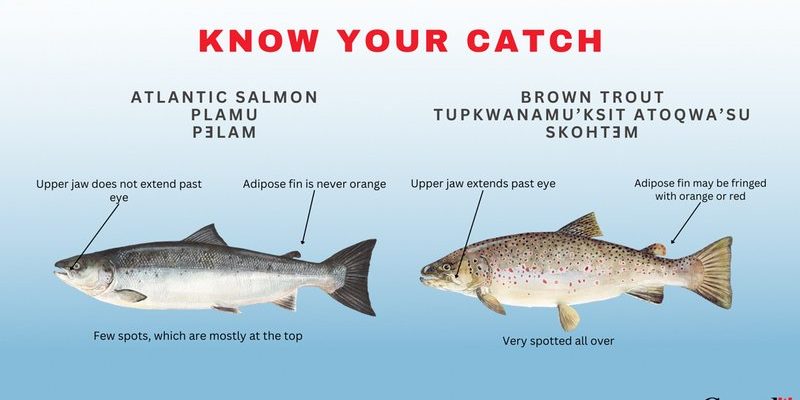![Comparing The Salmon Vs. [Similar Species]](https://gudri.com/wp-content/uploads/2025/06/Comparing_The_Salmon_Vs___Similar_Species__image_0.jpg)
Both salmon and trout belong to the same family, Salmonidae, which makes them close relatives. Imagine them as cousins, sharing similar traits but still boasting their own unique characteristics. Salmon generally have a richer, oilier flavor, while trout often possess a milder, sweeter taste. Understanding these differences can help you make a more informed choice the next time you’re at the grocery store or planning a fishing trip.
Physical Differences Between Salmon and Trout
One of the first things you might notice is the physical appearance of salmon and trout. Salmon are typically larger than trout, with species like the Chinook salmon growing to weigh over 100 pounds! Meanwhile, trout are generally smaller, with most species averaging 1 to 5 pounds. This size difference also plays into their overall texture. Salmon flesh is usually firmer, while trout is a bit more delicate.
Color is another distinguishing factor. Salmon, especially wild-caught varieties, often flaunt vibrant pink to reddish-orange flesh due to their diet, which is rich in carotenoids. Trout, on the other hand, come in various hues, from silvery to speckled bronze. You might even find rainbow trout, which sports a strikingly beautiful, colorful pattern. So, next time you see a platter of these two fish, consider how their colors can enhance your meal’s presentation!
Taste Profile: Salmon vs. Trout
When it comes to taste, the differences between salmon and trout can be pretty pronounced. Salmon is known for its rich, buttery flavor, which can be attributed to its higher fat content. This oiliness makes it perfect for grilling or baking, as it retains moisture and flavor. You might even say that salmon has a “luxurious” taste that can elevate a dish.
Trout, by contrast, offers a more subtle taste. Its flesh is often described as sweet and mild, which makes it versatile in the kitchen. Whether you’re pan-frying it with herbs or grilling it with a squeeze of lemon, trout doesn’t overpower other flavors. If you’re someone who enjoys a lighter meal, trout might be right up your alley.
Nutritional Comparison
Both salmon and trout are nutrient powerhouses, but they do have their differences worth noting. Salmon is often celebrated for its high omega-3 fatty acid content, which is great for heart health. Just a serving of salmon can provide you with plenty of protein, vitamins, and minerals. It’s like a mini health boost on your plate!
Trout isn’t far behind, either. It’s also a fantastic source of omega-3s, but with slightly less fat than salmon. Plus, trout is rich in B vitamins, particularly B12, which is essential for energy and proper brain function. If you’re focused on maintaining a balanced diet, both fish offer good options, but your choice may depend on your nutritional goals.
Cooking Methods: How to Prepare Each Fish
Cooking salmon and trout can be a lot of fun, but the methods might vary to get the best flavors out of each. Salmon lends itself well to a variety of cooking techniques. You can grill, bake, or even smoke it to enhance its rich flavor. One popular method is to marinate salmon with soy sauce, ginger, and garlic before searing it on the grill. The result? A mouthwatering dish that’s simple yet gourmet.
Trout, being more delicate, is best when cooked gently. Pan-frying or baking it with a light coating of flour helps keep the fish intact and adds a lovely crispiness. A sprinkle of lemon and fresh herbs can elevate the flavor without masking its natural sweetness. If you’re trying to impress guests, whole roasted trout stuffed with lemon and herbs makes for a stunning centerpiece.
Where to Find Salmon and Trout
If you’re wondering where to get fresh salmon and trout, you have a few options. Supermarkets often have both fish in their seafood sections, but the freshness can vary. It’s a good idea to check for wild-caught varieties if you’re looking for the best quality. Wild salmon is generally more flavorful than farmed, although both have their place in the market.
When it comes to trout, many fresh-water fish markets or local rivers and lakes might offer farmed or wild options. If you’re into fishing, catching your own trout can be a fun way to ensure you know exactly where your meal comes from. Just remember to check local regulations on fishing seasons and limits!
Environmental Considerations
Choosing between salmon and trout isn’t just about taste or nutrition; it’s also about sustainability. Overfishing has significantly impacted wild salmon populations, particularly in certain areas. If you decide to opt for salmon, look for sustainably sourced options or farmed varieties that adhere to environmental guidelines.
Trout, particularly farmed trout, is often seen as a more sustainable choice. Fish farms can help minimize the environmental impact by providing a controlled setting for fish production. Still, it’s important to research and choose farms that prioritize eco-friendly practices. By being mindful of where your fish comes from, you’re doing your part in supporting sustainable fishing practices.
Final Thoughts: Salmon vs. Trout
When it comes down to it, salmon and trout each bring their own unique appeal to the table. Whether you go for the rich, buttery taste of salmon or the mild, sweet flavor of trout, you can’t go wrong. Each fish offers a host of health benefits and culinary possibilities that can keep your meals interesting.
So the next time you’re faced with a choice, remember the differences in flavor, texture, and sustainability. Try both and see which one you prefer—they each have something delicious to offer! Happy cooking!

